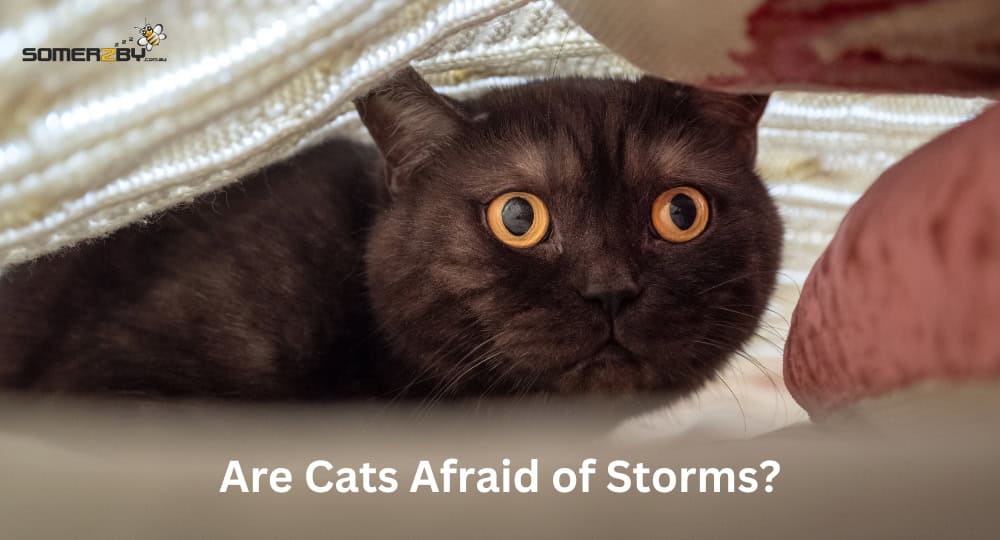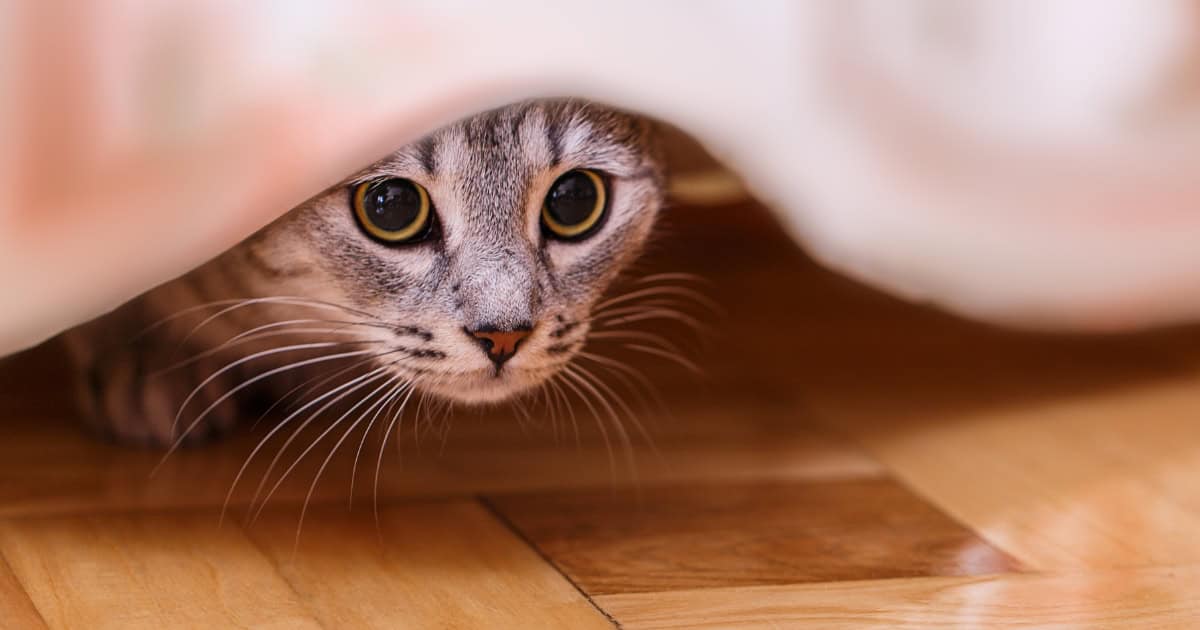Cats
Are Cats Afraid of Storms? Guide to Feline Weather Fear
Hi, I’m Toni and I’ve been a cat lover all my life. Are cats afraid of storms? That’s a question that sparked my curiosity.
I’ve spent countless hours researching this topic and observing my own feline companions during stormy weather. It turns out; it’s not as straightforward as you might think!
This isn’t just another pet blog – it’s a place where we can learn together about our furry friends’ behaviours and needs. Are cats afraid of storms? Let’s explore the answer together.
Please remember though – I’m not a vet or animal behaviourist. This is simply the shared experiences of one devoted cat lover to another.
What Causes Cats to Fear Storms?
Cats, much like their human companions, can be quite sensitive to changes in their environment. The unfamiliarity and intensity of storm events make them particularly distressing for our feline friends.
Loud Noises
A thunderstorm phobia isn’t uncommon among pets – especially those with keen hearing abilities such as cats. These creatures are equipped with ears capable of picking up sounds at frequencies far beyond what we humans can perceive or tolerate.
In fact, when a storm hits and thunder rumbles through the sky it can reach decibel levels akin to standing next to blaring speakers at a concert or a close proximity jet engine take off. It’s no wonder then why some kitties become visibly stressed during bad weather conditions.
Sensitivity to Changes in Air Pressure
In addition to the auditory disruptions brought about by storms, there exists another element that might be influencing your cat’s apparent fear of storms: fluctuations in air pressure that coincide with turbulent weather patterns.
Animals are particularly sensitive to these alterations in atmospheric conditions, unlike humans who might only notice such changes under certain circumstances (such as feeling ear pressure changes during a plane ride).
This shift can disturb a pet that is already anxious, resulting in an increased state of vigilance and anxiety throughout the duration of the storm, even before visible signs of the impending severe weather event manifest. This can have the potential to unsettle your pet and keep them on high alert during the storm.
Flashes of Lightning
Cats have exceptional night vision thanks primarily due to tapetum lucidum – a reflective layer behind the retina that enhances their ability to see low-light conditions. This makes them very susceptible to bright lights, especially sudden ones like flash lightning during thunderstorms.
How Can You Tell if Your Cat is Afraid of Storms?
Cats and thunderstorms are a combination that often leads to visible behavioural changes in your feline friend. Recognising these signs early can help manage your cat’s suspected storm fear.
Their behaviour could vary from subtle shifts to pronounced reactions, depending on the intensity of their anxiety.
Unlike dogs who may express their discomfort more overtly, anxious cats might internalise the stress until it becomes unbearable.
Detecting Thunderstorm Phobia Symptoms in Cats
Cats with thunderstorm phobia respond with several symptoms during storms, with hiding being the most common sign. Frightened cats tend to find solace under furniture or inside closets – an instinctive response to feel safe.
In addition, trembling could be another indication that they’re scared. The adrenaline rush caused by stressors like thunderstorms results in shaking.
Vocalising and panting are other significant indicators you should pay attention to. Unusual panting suggests distress while excessive meowing signifies discomfort linked with a potential thunderstorm anxiety response.
If they refuse food or water, it’s indicative of heightened levels of stress. In some instances, more aggressive behaviours like scratching at doors or windows signal exaggerated fear responses where they feel compelled to escape perceived threats.
An unexpected change in toilet habits (like urinating outside the litter box) during storms is also a red flag indicating high levels of stress brought about by these natural phenomena.
Veterinary Diagnosis
If you are unsure whether the symptoms you see are from your cat’s suspected storm fear, I recommend consulting a professional vet for advice.
Veterinarians diagnose based on patterns observed over time, along with physical examination findings such as checking a stressed cats elevated blood glucose levels or increased heart rate.
How Can You Help a Cat Who is Afraid of Storms?
If your cat exhibits signs of thunderstorm phobia immediately, such as hiding or trembling when the storm hits, there are several methods you can utilise to help keep your cat calm.
Quiet Safe Space
Cats often seek solace in a quiet safe space during stressful situations like storms. Offering your feline companion their own cat enclosure or an enclosed cat cave as a storm approaches can provide the security they crave. It’s crucial that this area is distant from windows where sudden noises and flashes may be more intense.
You might consider adding comfort items into this space such as blankets, pillows or comfy cat beds. Calming cat beds are designed to help anxious pets feel safe and secure.
Your cat’s favourite toys can also provide comfort. Anxiety toys like the Heart Beat ‘N’ Warm Kitty can be very soothing, with a microwavable warm pouch and a heartbeat device that helps your cat feel like another being is nearby.
Some cats find peace in elevated spaces, so providing cat trees or shelves could prove beneficial too.
As a storm approaches, try playing some calming music throughout your house; this has been shown to help keep a cat calm by masking any potentially frightening sounds caused by thunderstorms.
Use Calming Products
Feline pheromone-based calming diffusers have been shown to produce a calming effect on anxious cats. These diffusers emit synthetic versions of natural ‘happy’ pheromones which can aid in alleviating stress-related behaviours, including those linked with thunderstorm anxiety.
In addition to these diffusers, other calming aids available include special collars infused with relaxing scents or pet-friendly music designed specifically for stressed cat treatment purposes.
Fear Conditioning Techniques
To alleviate a cat’s fear of storms, behavioural modifications may help.
Focus on shifting the cat’s negative emotional response to storms into a positive one. By offering treats and playtime whenever the cat displays calm behaviour during stormy weather, the fearful association gradually transforms into an enjoyable experience.
Desensitisation therapy involves exposing your cat to low-volume thunderstorm recordings while rewarding calm behaviour, contributing to diminishing storm-related anxieties.
Veterinary Assistance
If, despite trying all these measures above, you still notice persistent symptoms indicating severe distress levels, then seeking professional veterinary assistance would be advisable. Prolonged stress episodes could lead to mental and physical health complications.
The decision on when you should seek veterinary help depends largely on how severely your cat reacts during storms and whether these reactions are affecting its quality of life, such as stopping it from eating or drinking.
If your cat shows symptoms of severe thunderstorm phobia immediately contact a professional for advice. Veterinarians diagnose thunderstorm anxiety in cats by observing symptoms and behavioural changes during or after storms.
Many vets will first suggest trying natural methods, such as those suggested above – feline pheromone-based calming diffusers, relaxing music, offering safe spaces and fear conditioning. It is important to remember each cat is unique and you may need to try a few different things before you find something that works for your cat.
In some cases where home remedies aren’t enough and stress continues even post-storm, veterinarians may recommend medications specifically designed for treating feline anxiety disorders.
If a cats veterinarians diagnose thunderstorm phobia, they will most likely suggest feline pheromone-based calming diffusers first. If these aren’t enough and severe symptoms continue, vets may recommend feline anxiety medication.
Toni’s Wrap
Are cats afraid of storms? Storms can indeed rattle our feline friends. The loud thunderclaps, bright lightning flashes, and changing air pressure are enough to unsettle even the most stoic kitty.
Observing your cat’s behaviour during a storm is crucial. If your cat’s anxiety is impacting its life, it might be a thunderstorm phobia.
You’re not helpless though! Creating a quiet safe space for your pet in stormy weather can have a calming effect.
If anxiety persists despite these efforts, it might be time for a vet visit. They’ll provide further evaluation and treatment options if necessary.
Your beloved feline deserves comfort during turbulent times just like us humans do – let Somerzby assist you in creating that secure environment with our range of outdoor pet enclosures designed with love and care for animals’ well-being amidst unpredictable Australian weather conditions!







